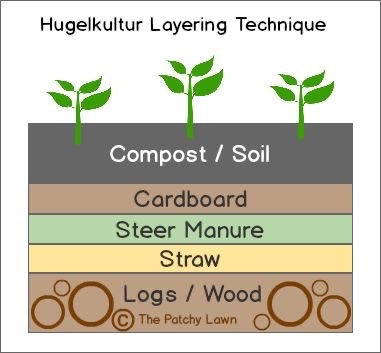#hugelkultur
Text
Stump Hugelkultur part 1/?
So we got a city ordinance violation for having a bunch of fallen trees, logs, and stumps in our yard 🤪 I'm not happy because we don't have the time or money really right now and it's literally 7 medium to large trees worth of wood to clear up. But we have a month deadline so here we go I guess.
Of course being me I don't want to pull up a stump or try to decay it under a tarp, so I'm attempting to make hugelkultur beds on them instead. If you don't know what that is, here's a diagram explanation.
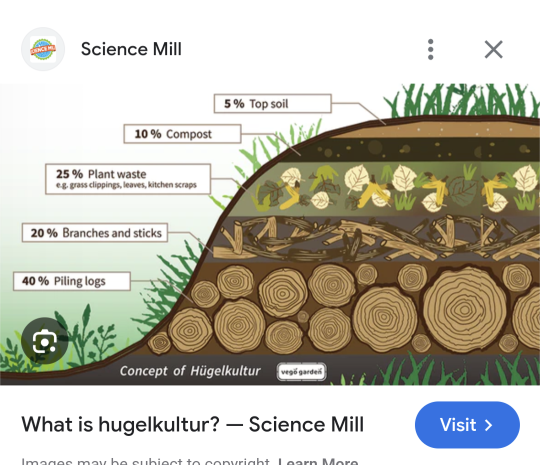
What I'm doing isn't really the traditional method because 1) I need it to look nicer so that we don't get slammed for just burying the stumps, and 2) it looks like normally hugelkultur is done with logs rather than stumps. So really I'm doing a hugelkultur inspired raised garden around a stump. Here's where we're at so far


Above is the one that's farthest along. Tomorrow I'm going to put top soil over it, but for the time being I just covered it with cardboard so that the wind doesn't blow the grass away. While I don't want to spend more money rn cuz we just bought a chainsaw, there is a native plant sale nearby in the next couple days that will be cheaper than going to a nursery. So I'm going to go and try to make this a native pollinator garden.
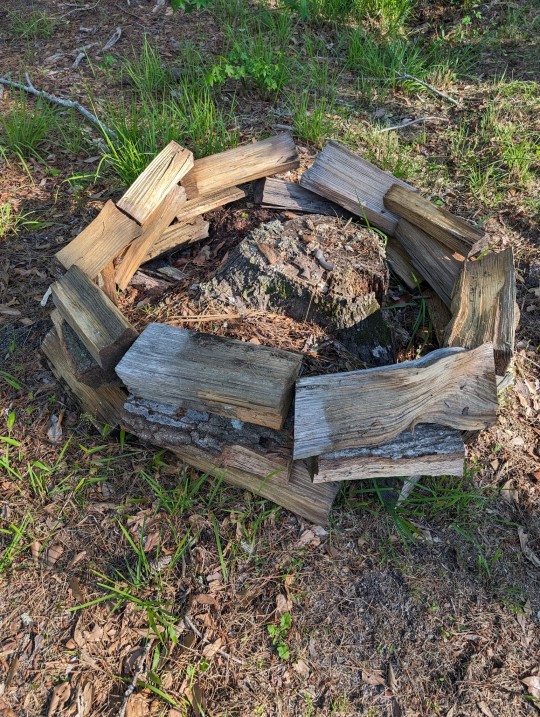

And here's two others in the works right now that haven't been buried in sticks and leaves yet. I think we have 2 more stumps after this to hide, so we kinda will end up with 5 random raised garden circles. Not what I expected to do with this yard but do what you gotta do to decay a stump I guess haha
18 notes
·
View notes
Text
Gardening in Raised Beds On Pavement
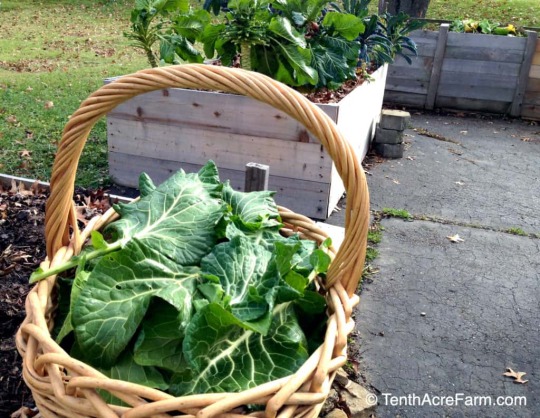
Growing in raised beds on top of pavement is an excellent strategy if you have limited growing space. Let's learn how to make the most of that concrete or asphalt!
Build Tall Beds
Crops need room to send roots down into the soil. Providing plenty of room to grow means your crops have a strong foundation, hold moisture longer, and can access more nutrients in the soil through deeper roots. Raised beds on pavement should be a minimum of 24 inches tall and ideally 32 inches tall! Taller is always better, especially if you live somewhere with hot and/or dry summers.
Filling Your Raised Beds
When you build raised beds on the ground, your crops have access to the soil underneath for draining excess water from above and wicking water up from below. Building on pavement takes this away, so how we fill the beds really matters!
Bottom Layer: Gravel
Fill the bottom of your raised beds with about 6 inches of gravel. This helps fight erosion, helps with drainage, and keeps your crop's roots from coming into contact with the pavement.
Middle Layer: Decomposing Wood
I highly recommend the hugelkultur method. A hugelkultur, or "mound culture" in German, is a raised bed with a base of decomposing wood. Rotting wood encourages fungal networks, holds moisture, and fills the space pretty cheaply. Get some logs, sticks, and other dead wood pieces and make a layer on top of your gravel.
Top Layers: Loose, Rich Growing Medium
There's lots of options for filling this space, but the goal is high-quality organic matter. Avoid bags of potting soil, as these aren't living soil. Living soil self-renews and keeps providing a nutrient rich environment. Potting soil will eventually dry out and lose nutrients. Instead gather things like:
Compost (homemade or purchased)
Coffee grounds (many coffee shops are happy to give out used grounds for free)
Living soil (from your yard or garden, even just a few shovels full will likely contain fungal networks and earthworms)
Grass clippings (not sprayed with anything!!)
Kitchen scraps (egg shells, fruits, veggies)
Leaf mold (leaves that have aged for two years)
Livestock manure
Shredded office paper
Worm casings
Alternate layers of whichever of these materials you're able to get and make a big raised bed lasagna. Save your compost for the top lasagna layer. Then top the whole bed off with mulch! Mulch helps hold water and keeps weeds at bay.
The Best time to Build Raised Beds is in the Fall
You can build beds any time, but building in the fall gives your bed contents time to settle and break down over the winter. Your lasagna layers need time to break down into finished soil, which crops generally prefer. Then just add some more organic matter on top in the spring before planting.
What To Plant
Here's some crop suggestions to go easy on your garden in the first year. After the first year though the sky is the limit!
Beets
Herbs
Leafy greens
Legumes
Onions
Maintaining Raised Beds on Pavement
Irrigate: Even with your fabulous organic material lasagna, your raised bed on pavement will still dry out. Prepare to water regularly, especially in the seed and seedling phase. After your crops get established a deep weekly watering should be enough unless it's extremely hot/dry.
Fertilize: During the summer, add some liquid fertilizer every couple of weeks (during your watering sesh) to push nutrients down into the soil. Some great liquid fertilizer options are comfrey tea, fish fertilizer, and worm tea.
Soil Renewal: Every fall top your beds off with some new organic matter. Over time your raised beds will decompose and sink, so fill those babies back up so they're ready for next spring! And don't forget to mulch!
Aerate: As your layers decompose you'll want to do some gentle aerating with a digging fork to keep the soil loose and crumbly.
Use Cover Crops: Cover crops help enrich the soil and keep it from drying out.
Summer cover crops: Buckwheat, cow peas, millet
Winter cover crops: Daikon radish, oats, winter rye
Happy growing!!
Source
#gardening#urban gardening#small space gardening#raised beds#hugelkultur#suburban gardening#urban farming
160 notes
·
View notes
Text

Doing some Hugelkultur with logs from our great cherry tree that we had to have cut down a few years ago.
Next will be smaller sticks and twigs, then smaller stuff, then dirt and compost.
13 notes
·
View notes
Text


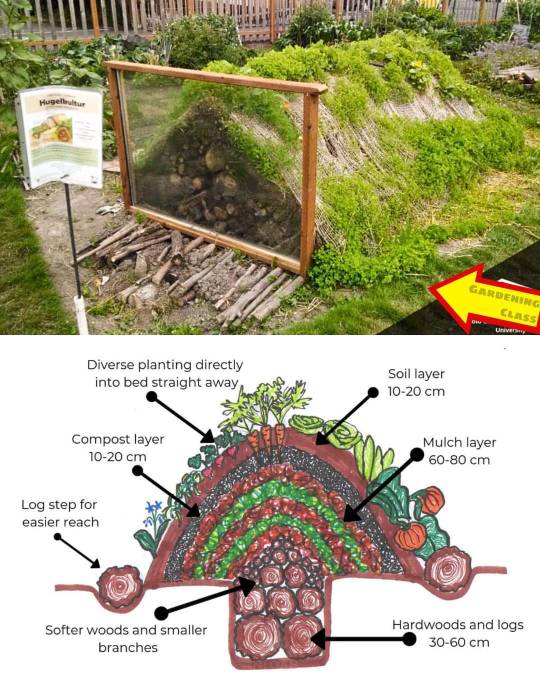

The map with birds on it is the national bird of each country pictured. I have no idea if it is accurate.
#acceptable maps#birds#charts#nuclear energy#cathedrals#architecture#hugelkultur#gardening#gothic architecture#nuclear subs#ecology memes#meme dump
2 notes
·
View notes
Text
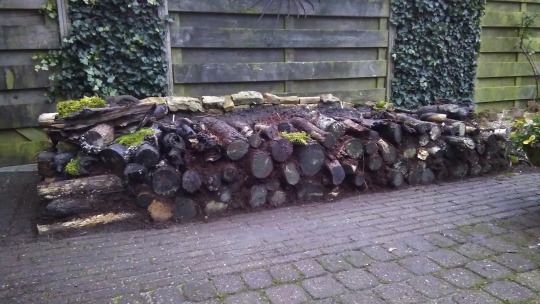

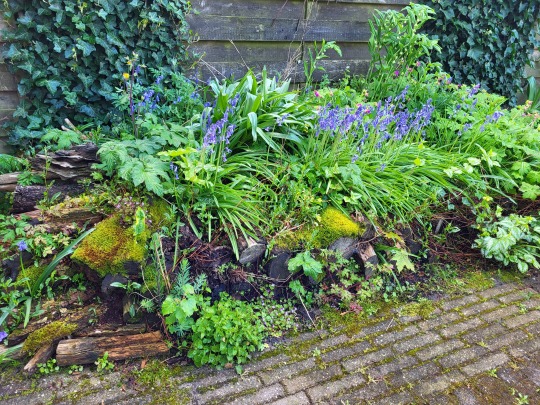
before and after of my small hugelkultur.
4 notes
·
View notes
Text
Permaculture Lessons, part two: Disabled Permaculture
Permaculture Lessons, part two: Disabled Permaculture
This is a guest post by Laura-Marie River Victor Peace Nopales (see contact info below).
Hello! I made a guest post on Awkward Botany in March, introducing myself and my spouse, and talking a little about my life with permaculture. Permaculture is a way I learn about plants, love the earth, grow delicious foods, and connect with others. Permaculture has a community aspect, and respect for all…

View On WordPress
#bipolar#community gardens#compost#disabled#food forests#food not bombs#fruits#gardening#guest post#Harlequin bugs#herbs#hugelkultur#Laura-Marie River Victor Peace Nopales#narcolepsy#permaculture#permaculturist#tree collards#vegetable gardening#vegetables
37 notes
·
View notes
Text
When Life Gives You A Hurricane You Make Hugelkulturs!
(Heads Up:Long Post)
So this was my first hugelkultur and I'm exited to see how it turns out.
(I have some worries about the heat from the logs since it already gets pretty hot out here but time will tell)
I figured it would be a good way to make use of all the branches and trees ppl are cutting to clear the roads and stuff. I'd seen a few people talking about them on this site and was interested in trying it out for myself so i did!
I gotta say I thought this would be more of a weekend project, but it's taken me over a week to lug all that dirt around.
(Granted I only worked a fixed amount each day to make sure I didn't push myself cuz burnouts a bitch)
Hopefully it'll all have been worth it!
Like most things in life we begin with hole 🕳
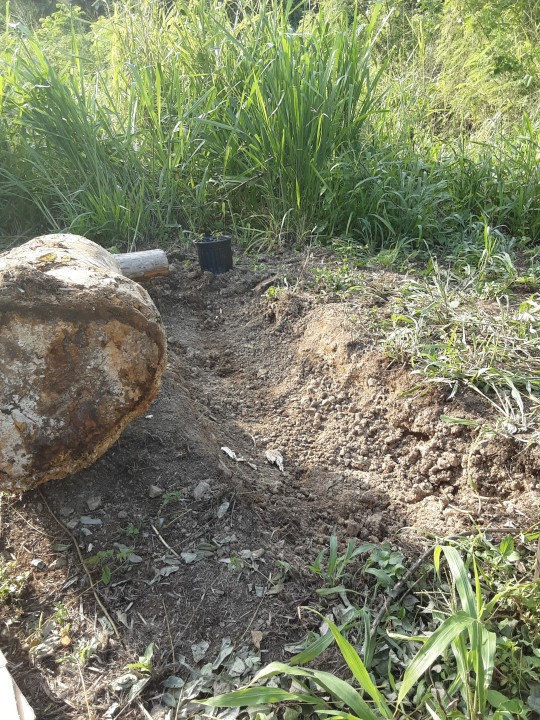
Got some cardboard from the back of a bakery I like and set it as our base.

Originally I was just going to use a few logs from some trees my uncle cleared out before the hurricane but I found this super log on the side of the road and I JUST HAD to have it. My car still has dirt in it and my back is still messed up but I'd say it was worth the trouble.
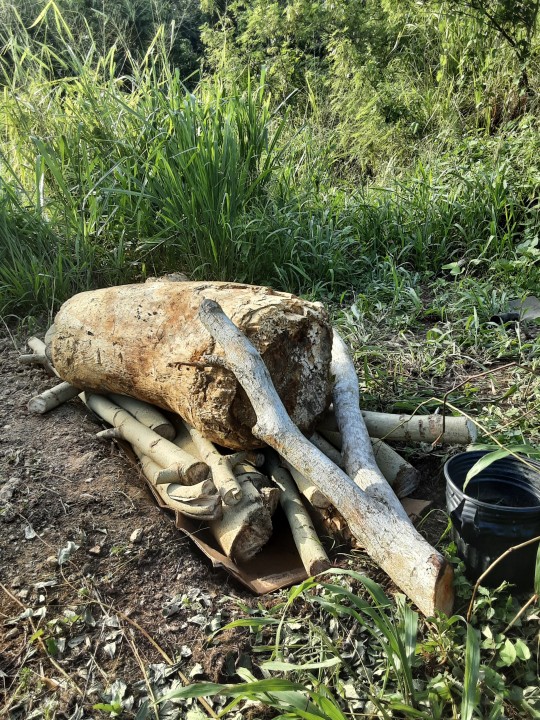
I also got a hold of some mango and almond logs which is great cuz I wanted some tougher woods in there for longer term nutrients and support.

I slapped some branches on there and threw in a few plantain plants that fell during the hurricane (para sazón)
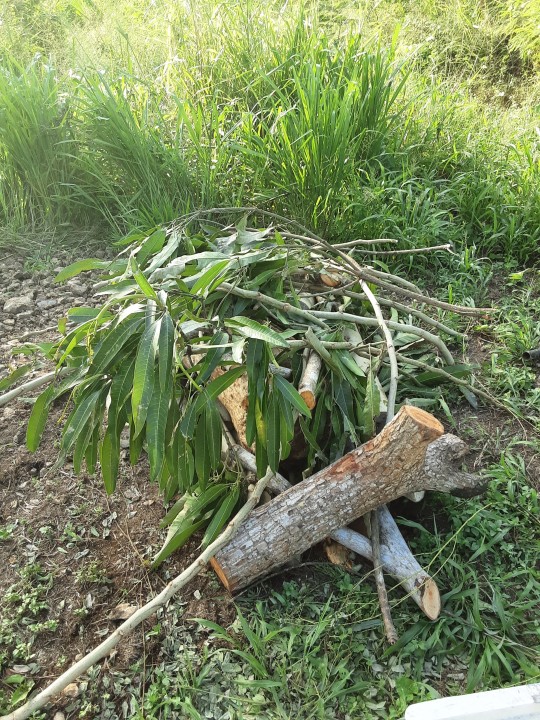

At this point I was sure the hard part was behind me and that I was only 3 wheelbarrow's worth of dirt away from being done. But my hubris was quickly punished as I realized I was going to be needing a little more dirt than that...
I told myself "just do 3 more tomorrow and we'll be done"
And then I told myself that same thing every day until a week had gone by... 😪
But now it was done and I had a big ol hill of dirt!
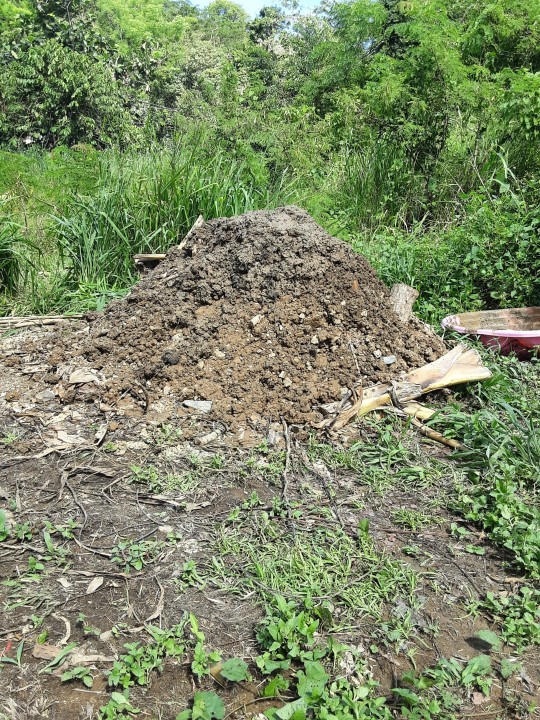
Then I added some leaves I saved from the branches I used earlier in the week to give our gal a little bit of a crunch!

Sprinkled in some organic waste
(Mostly eggshells, garlic peels, old plantains that went bad, cofee grounds)
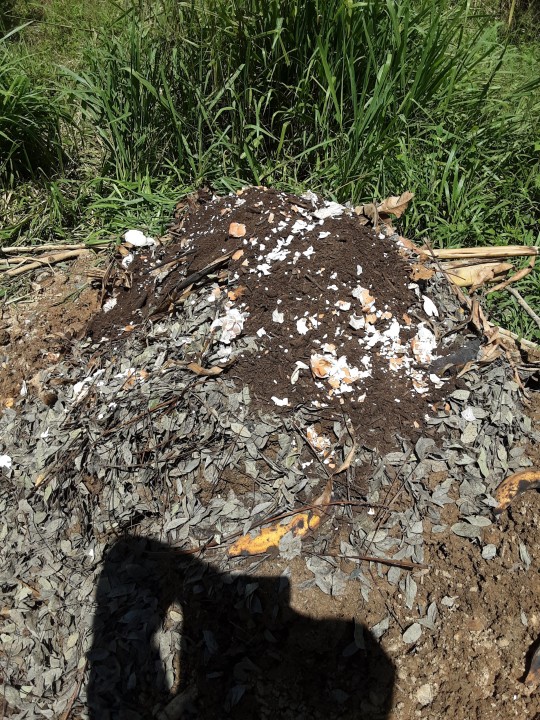
After that I just threw some bags of top soil from the local hardware store on top of the old gal and we were good to go!
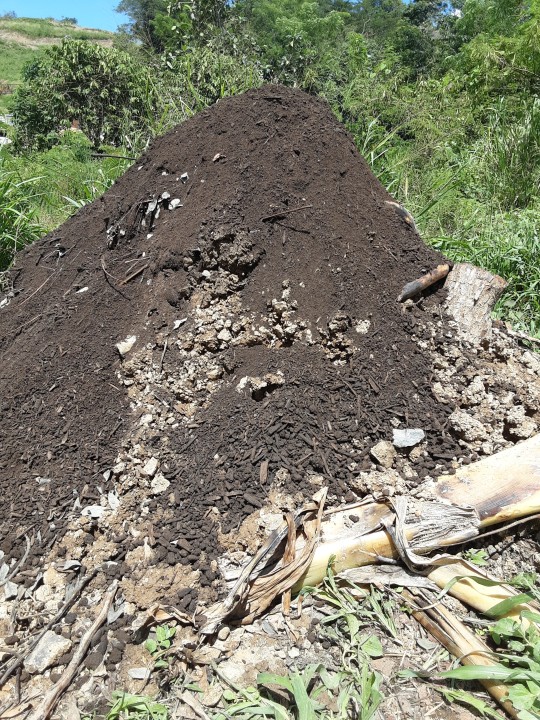
5 notes
·
View notes
Text

@spittletooth
Yes! I'd love to answer this!
The logs and sticks have quite a few reasons for being there!
Where we live, we have very poor, sandy soil, and are on a hill. We have to use alternative gardening methods to create nutrient rich garden beds like lasagna or hugelkultur gardening.
Hugelkultur gardening is set up a lot like lasagna gardening. It uses layers of substances (compost, leaves, grass clippings, soil, ect.) to create a long lasting source of nutrients as well as invite beneficial insects and bacteria. Lasagna gardening tends to use cardboard as a layer instead of logs to create a moisture retaining layer.
In hugelkultur gardening, using decayed logs at the bottom helps retain moisture, break down slowly, and create lasting nutrients for the garden bed.
Logs soak up moisture and hold it like a sponge, releasing it slowly which helps tap roots in plants to grow longer (helping the plants stay cool on hot days which also keeps them from drying out as quickly). They take longer to decay than typical grass clippings, leaves, or compost and might take years to finally rot away, giving the bed a more lasting source of humus (decomposed organic matter). This gives the garden bed a much longer life (5-7 years) than lasagna gardening (1-3 years depending on layers and depth).
Plus, as the logs decay they give off some amount of heat, keeping the bed warmer on cooler days (which in the north is helpful).
As an added bonus! It's a great filler for the bed so we dont have to use as much soil and is a great alternative to burning excess logs and yard clippings.
Hugelkultur gardening is typically done in a mound or hill (it's literally "hill culture" when translated) but when we tried it, we couldn't form a steep enough mound and for ease of labor, we decided to adapt it into a raised bed form. Easier on knees and backs.
#homestead#hugelkultur#long post#sorry i gave you a novel#i really love this type of gardening#i didnt expect to infodump on this#hope this answers the question clearly!
11 notes
·
View notes
Text
Hugelkultur Part 2/2
Lol sooooo this flopped pretty hard. See part 1 for pictures and such. Basically I wasn't able to fill up the bed with enough soil, which is mostly a time and financial issue at the moment. So no plants can take there since the soil layer isn't deep enough. Luckily I didn't buy anything to plant there, I just transplanted random stuff from my yard that would've otherwise been torn down. But hey, now I know where some mistakes were made haha. My plan at this point is to keep layering dirt, leaf litter, and fresh plant clippings as I get them until it's an actually solid bed, and then maybe start using it next year. I don't really have the resources or energy right now to start a garden anyways so I think this is fine.
2 notes
·
View notes
Photo

First phase of the hügelkultur! Can’t wait to see this project grow. 🪵🌱#permaculture #lovingtheland #hugelkultur #natureisamazing https://www.instagram.com/p/Cegc1X-LDai/?igshid=NGJjMDIxMWI=
3 notes
·
View notes
Text
Perennial Melodies
Been waiting for the hollyhocks to bloom
They’re growing in a hügelkultur bed.
I thought if not this month then maybe June
I thought on those kind words you left unsaid.
And un-affirmed, our love slowly decayed
Thus making rich the soil for my songs
Perennials whose seeds fell by the shade
Though in the light is where they now belong.
—rudysassafras

rudysassafras
#poem#poetry#poema#rudysassafras#hollyhocks#photo#nature#flowers#hugelkultur#iambic pentameter#garden
3 notes
·
View notes
Text
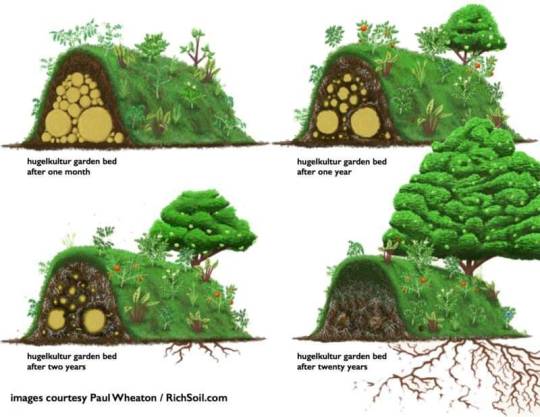
Hugelkultur:
A link from MSU Extension Master Gardeners regarding this fascinating form of gardening. Hugelkultur incorporates a compost pile directly into the garden bed:
https://mgsoc.org/2019/01/hugelkultur-what/
Below, another diagram and examples of what a finished Hugelkultur garden might look like.
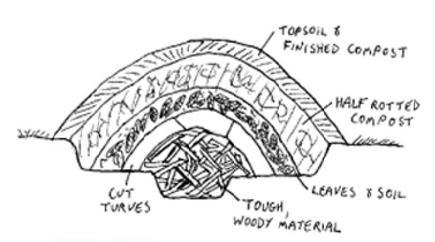


6 notes
·
View notes
Text
youtube
See the whole blogpost at - https://backroadshomesteading.com/soil-testing-and-boat-troubles/ Hello, friends! Ryan here from Backroads Homesteading. Today, I want to share some updates on our homestead journey, focusing on soil testing for our garden beds and our boat repair adventures. Rumble Version - https://rumble.com/v4hmyo5-homestead-life-boat-issues-and-soil-testing.html X Version - https://twitter.com/bkrdhomstd/status/1765448065907900603 Facebook Version - https://fb.watch/qEsLbBffsV/ Instagram Version - https://www.instagram.com/p/C4Lr5eIgwdy/
#homesteading#boatrepair#soiltesting#gardenbeds#hugelkultur#raisedbeds#composting#mulching#sustainability#DIYprojects#Youtube
0 notes
Text
Hence the reference to 'hill'.
"Soil: The incredible story of what keeps the earth, and us, healthy" - Matthew Evans
0 notes
Text
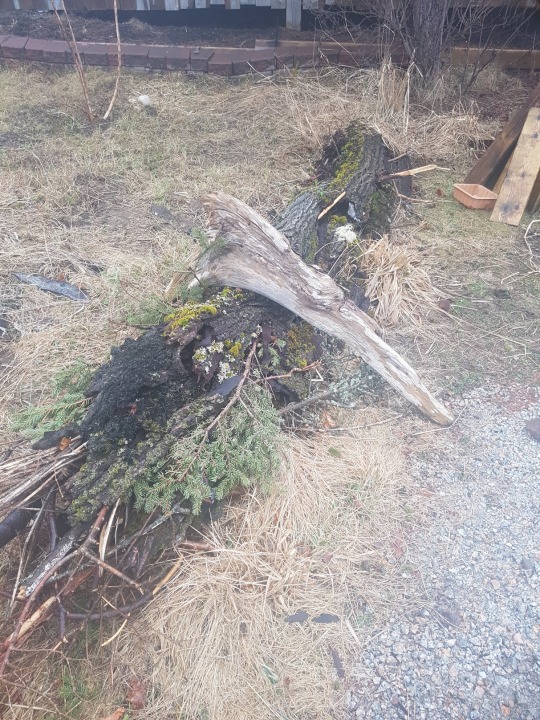
Is this the start of hugelkultur?
1 note
·
View note
